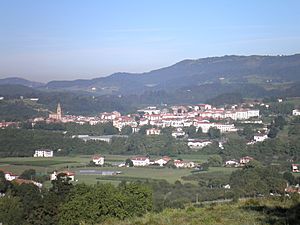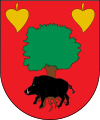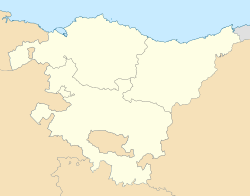Usurbil facts for kids
Quick facts for kids
Usurbil
|
||
|---|---|---|
 |
||
|
||
| Country | Spain | |
| Autonomous community | Basque Country | |
| Province | Gipuzkoa | |
| Comarca | Donostialdea | |
| Founded | September 11, 1371 | |
| Area | ||
| • Total | 25.64 km2 (9.90 sq mi) | |
| Population
(2018)
|
||
| • Total | 6,165 | |
| • Density | 240.44/km2 (622.75/sq mi) | |
| Demonym(s) | Basque: usurbildarra | |
| Time zone | UTC+1 (CET) | |
| • Summer (DST) | UTC+2 (CEST) | |
| Postal code |
20170
|
|
| Official language(s) | Basque Spanish |
|
Usurbil (also known as Spanish: Usúrbil) is a town and region. It is located in the province of Gipuzkoa. This area is part of the Basque Country in northern Spain.
Usurbil is famous for its sagardotegiak, which are traditional cider houses. The area near the river is also well-known for its eels.
Contents
Geography
Usurbil's Boroughs
Usurbil is made up of several smaller areas called boroughs.
- Elizalde, Kaxkoa, and Kaleberri are in the town center. Most people live here. They are often just called Usurbil.
- Aginaga is known for eel fishing. It is on the road to Orio. About 450 people live here, and it has its own church area.
- Atxegalde is a district near the main motorway. Around 500 people live in this area.
- Txikierdi is a small place close to Lasarte-Oria. It is surrounded by factories and is part of the Urbil Industrial Estate.
- Kalezar is an older borough. It is located on a hill overlooking the Oria River valley. Its name means "the old street." About 650 people live here.
- Urdaiaga (or San Esteban) is on the western side of town. It has 175 inhabitants. It is often called by the name of its church.
- Santu Enea is on the western side of the Oria river. It has just over 500 people living there.
- Zubieta is a unique district. It is split between Usurbil and Donostia (also known as San Sebastián). Zubieta is on the western bank of the Oria river. It is like a small piece of Donostia surrounded by Usurbil and Lasarte-Oria.
- Txoko Alde
- Santu-Enea
Nearby Areas
Usurbil shares borders with several other towns and districts.
- To the north, it borders Donostia's Igeldo and Añorga areas.
- To the east, it borders Lasarte-Oria and Zubieta.
- To the south, it borders Zizurkil.
- To the west, it borders Aia and Orio.
Donostia, the capital city of the region, is about 11 kilometers (7 miles) away. Lasarte-Oria is only 2 kilometers (1.2 miles) away, and Orio is 10 kilometers (6 miles) away.
Climate
| Climate data for Usurbil | |||||||||||||
|---|---|---|---|---|---|---|---|---|---|---|---|---|---|
| Month | Jan | Feb | Mar | Apr | May | Jun | Jul | Aug | Sep | Oct | Nov | Dec | Year |
| Daily mean °C (°F) | 8 (46) |
9 (48) |
10 (50) |
12 (54) |
14 (57) |
17 (63) |
19 (66) |
20 (68) |
18 (64) |
15 (59) |
11 (52) |
8 (46) |
13 (55) |
| Average precipitation mm (inches) | 115 (4.5) |
94 (3.7) |
98 (3.9) |
138 (5.4) |
111 (4.4) |
108 (4.3) |
83 (3.3) |
100 (3.9) |
123 (4.8) |
151 (5.9) |
170 (6.7) |
134 (5.3) |
1,425 (56.1) |
| Source: Weatherbase, | |||||||||||||
History
The earliest signs of people living in this area are found on Andatza mountain. Here, you can see ancient neolithic burial mounds and tall menhir stones.
Many believe that Usurbil was once part of a larger area called Hernani. This area stretched between the Urumea and Oria rivers.
The oldest settled part seems to have been on the left side of the Urumea river. This roughly matches the modern Urdaiaga area. A document from the 1200s mentions a Monasterio de San Esteban. This monastery is now gone, but it was the basis for the current San Esteban hermitage. A tower-house was built next to the monastery in the 1300s. This building gave the area its name, Urdaiaga.
In the 1100s, a large piece of land in Usurbil was given to a monastery in Orreaga, Navarre. This land stayed with the monastery until 1836. After that, the area of Mount Irisasi and Andatza was planted with trees. Today, it is one of the best-preserved forest areas in Gipuzkoa.
In 1180, King Sancho VI of Navarre added Usurbil and most of Zubieta to the areas controlled by Donostia. At that time, people lived in small, spread-out groups. These groups formed the beginnings of modern Urdaiaga and Aginaga. The main church was built where it stands today. The most powerful family was the Atxegas. They owned a tower-house near an important river crossing on the Oria.
This situation changed in 1371. The Castilian King Henry II of Castile allowed the people of San Salvador to create a new town. This new town was called Belmonte de Usurbil. It was independent from Donostia. The new town was built on a hill away from the Oria river. This was done to avoid the influence of the Atxega family. The church ended up halfway between the new town and the Atxega tower-house. The borders kept changing. Orio was originally part of Usurbil. But in 1379, it became its own independent town.
Towards the end of the 1300s, the Zubieta area had a choice. They could stay with Donostia or join Usurbil. Fourteen households chose to stay with Donostia. The other seven joined Usurbil.
The old design of Belmonte de Usurbil was simple. It mainly had two streets running side by side. This layout matches the modern Kalezar borough well.
In 1486, a fire destroyed all of Belmonte de Usurbil. As the Atxega family lost power, Belmonte also became less important. In the 1500s, other boroughs like Aginaga, Urdaiaga, Zubieta, and Elizalde started to challenge Belmonte's special rights. For example, Belmonte had a rule that slaughterhouses could not be built outside its town walls. Aginaga, especially, started many court cases.
As the old center declined, new areas grew. These areas would later become the town's center. The Elizalde borough, which means "side of the church" in Basque, started as a few houses built near the church. Because of the constant legal fights between Aginaga and Belmonte, the town council moved to Elizalde in 1672. By the end of the 1600s, Belmonte and Elizalde were similar in size.
The changing names of places also show this shift in power. Kaleberri (new street) now stood out against Belmonte's new name, Kalezar (old street).
In 1826, Usurbil joined with nearby Orio and Zizurkil. They formed the Union of Andatzabea. This union helped them pay for a shared representative. This representative would attend the Gipuzkoako Batzar Nagusiak, or Grand Council of Gipuzkoa.
Economy
Usurbil's traditional industries were ironwork, making anchors, and building ships. They used the many trees in the area for these crafts. At the shipyards in Mapil, Aginaga, ships were built for the Spanish Navy.
Modern industry came to Usurbil in 1934. A Michelin tire factory was built between Usurbil and Hernani. This factory gave jobs to many local people. Usurbil itself was not greatly changed by this, but Lasarte, which was closer, grew a lot. It became a town of about 20,000 people. Even with less production today, the factory is still a big employer. It has about 1700 workers. It is also one of the few factories in the world that makes Michelin motorcycle tires.
Many small and medium-sized businesses (SMEs) are also in the area. Important ones include Ingemar, which cuts and polishes marble and granite. Another is Victorio Luzuriaga Usurbil in Txikierdi, which is a smelter (a place where metal is melted). Both of these companies employ around 300 people each.
Administration
Usurbil is governed by a Mayor and a town council.
| 2007 | Xabier Mikel Errekondo (EAE-ANV) |
| 2003 | Luis María Ormaetxea (EA) |
| 1999 | José Antonio Altuna (EH) |
| 1995 | José Antonio Altuna (HB) |
| 1991 | José Antonio Altuna (HB) |
| 1987 | José Antonio Altuna (HB) |
| 1983 | Martín Larrañaga (EAJ-PNV) |
| 1979 | Andrés Bruño (EAJ-PNV) |
In Usurbil, political parties that support Basque nationalism usually get a lot of votes. They often receive between 75-80% of all votes. These votes are split almost evenly between moderate nationalist parties and leftist nationalist parties.
After Spain became a democracy again, the first two mayors of Usurbil were from the EAJ-PNV party. In 1986, the EA party separated from EAJ-PNV. After this, the next three mayors were from Herri Batasuna (or its later party, EH). Jose Antonio Altuna was mayor for 16 years. When Herri Batasuna was declared illegal, Altuna could not run for mayor in 2003. Luis Maria Ormaetxea from the EA party then became mayor.
In the 2005 elections for the Basque Government, the Basque nationalist group PNV-EA won. They received 39.3% of the votes. The independentist party EHAK came next with 33.3%. PSE-EE/PSOE got 11%, Aralar got 6%, and Partido Popular got 5.8%.
Gastronomy
Usurbil is famous for two special food products: glass eels and cider. Glass eels used to be common in most Basque rivers. In the Oria river, they would swim upstream as far as Aginaga. The people of Aginaga became very skilled at catching these eels. Angulas de Aguinaga, which are glass eels cooked with oil and capsicum (peppers), are well-known throughout Spain. However, glass eels have become rare due to pollution, which has made their price much higher.
Sagardoa (cider) is another important product. Usurbil, along with Astigarraga and Hernani, is one of the main cider towns in Gipuzkoa. Cider production decreased in the 1980s. Out of three factories that made sparkling cider in the area, only one remains. Starting in 1981, Usurbil began the Sagardo Eguna (cider day) event. This event gave new energy to the cider industry. It was so successful that other towns have also started their own cider days. Today, cider production is growing again. The area still has many traditional and modern sagardotegiak (cider houses).
Sport
The main sports center in Usurbil is the Polideportivo Oiardo. It opened in 1990. This center has seats for 500 people. It also has a covered swimming pool, squash courts, a gym, and an outdoor football field. Most local sports clubs are based here. These include the Usurbil Kirol Elkartea (Usurbil Sports Club), the Judo Club Usurbil (Spanish), and karate clubs, and Andatza KKE.
There is also a football stadium called Harane. The city council owns this stadium. The Usurbil Futbol Taldea football team plays here.
More sports facilities are available at the Ikastola Udarregi school. It has a multi-purpose fronton (a wall for playing pelota) and a concrete track. The Kontseju Zaharra fronton is in the center of Usurbil, next to the church. It is a covered fronton with extra tracks for Basque rural sports. Aginaga and San Esteban-Urdaiaga also have covered pelota courts. Zubieta has a fronton built for the joko-garbi type of pelota. This type of pelota is very rare in Gipuzkoa today.
Famous people
- Imanol Agirretxe (1987); footballer for Real Sociedad
- Jose Antonio Artze (1939); writer and musician. He helped bring back the txalaparta instrument with his brother.
- Xabier Bengoetxea; footballer
- Xabier Carbayeda Etxeberria (1966); cyclist and sports director for Euskaltel–Euskadi
- Xabier Mikel Errekondo (1964); international handball player
- Andoni Iraola (1982); former footballer for Athletic Bilbao and current AFC Bournemouth manager.
- David Asensio López (1980); footballer for various teams including Athletic Bilbao
- Haimar Zubeldia (1977); professional road racing cyclist for UCI ProTeam Lidl–Trek.
- Félix Mendizábal (7 March 1891 – 15 July 1959) was a Spanish sprinter.
See also
 In Spanish: Usúrbil para niños
In Spanish: Usúrbil para niños




